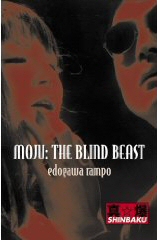Shinbaku Books present the finest Japanese counter culture books available including :
by Edogawa Rampo, 1932

In its first English translation courtesy of Shinbaku Books, Moju: the Blind Beast is one of the most sexually-perverse and violent stories in author Edogawa Rampo's extensive canon. Rampo (real name Taro Hirai; he adopted the pen-name of Edogawa Rampo as a phonetic Japanese rendering of his literary hero Edgar Allan Poe) was an accomplished mystery fiction writer and also, a proponent of the Japanese 'ero-guro' or 'erotic-grotesque' genre. Moju, with its sexually-charged account of kidnap and sadomasochistic violence, very much falls into the latter category.
The novella describes a blind artist who has learned to 'see' the world entirely through touch. He has created an extraordinary array of sculptures designed to be felt, not seen - but in order to truly appreciate beauty he decides he must find an attractive woman. He hears that Mizuki Ranko, a singer, is widely considered as one of the most beautiful women in Japan and when he uses his hands to explore a sculpture of Ranko kept in the museum, he decides he must have her, plotting her kidnap.
What follows is a grotesque game of cat and mouse. After finally tricking her into entering his house, the blind artist takes Ranko into the barely-lit basement where he has spent five years crafting sculptures of the human form. The room is full of disparate body parts which vary wildly in size, shape and texture - and Rampo's description of this bizarre place is one of the strongest points of the novella. At first Ranko is terrified of her obsessive gaoler and tries to escape or to keep him away, but she soon begins to feel "a disturbing affection for [the] baffling underground world", and yields to him. However, having finally secured Ranko's submission, and having spent months exploring each other's flesh, both parties grow bored. The artist begins to experiment with wounding Ranko, and finds not only that this reignites their aberrant passion, but that he is developing an idea for a new large-scale artistic projectů
This is a disturbing tale, where the real relish with which Rampo describes violent and erotic scenes clashes with the detached, semi-ironical tone displayed elsewhere. The difference between the brief, episodic structure and the grim subject matter all adds to a general feeling of strangeness which pervades this story. This is also a completely morally-ambivalent tale: Rampo isn't interested in portraying the artist's actions as criminal, and although other characters in the story voice this opinion, there is no punishment at the hands of an outraged society here. He is only interested in proselytising on the possibilities, erotic or otherwise, of a completely tactile existence - what the artist refers to as "the art of touch". 'Ero-guro' genre fiction is most definitely an acquired taste - and perhaps this story doesn't quite match up to the skin-crawling body horror of The Caterpillar (1929) - but this is an interesting novella, and a worthwhile history lesson in the development of that peculiarly Japanese marriage of sex and violence. It succeeds in being compelling and repellent!
This edition comes with a useful five-page introduction by Eros in Hell author Jack Hunter, which contextualises the novella and talks about cinematic versions of Rampo tales, particularly Yasuzo Masumura's 1969 version of Moju, providing two black and white stills from the film. The book is also illustrated in black and white throughout.
Review by Keri O'Shea
For ordering details click here
To find out more about the Shinbaku Books line click here
Back